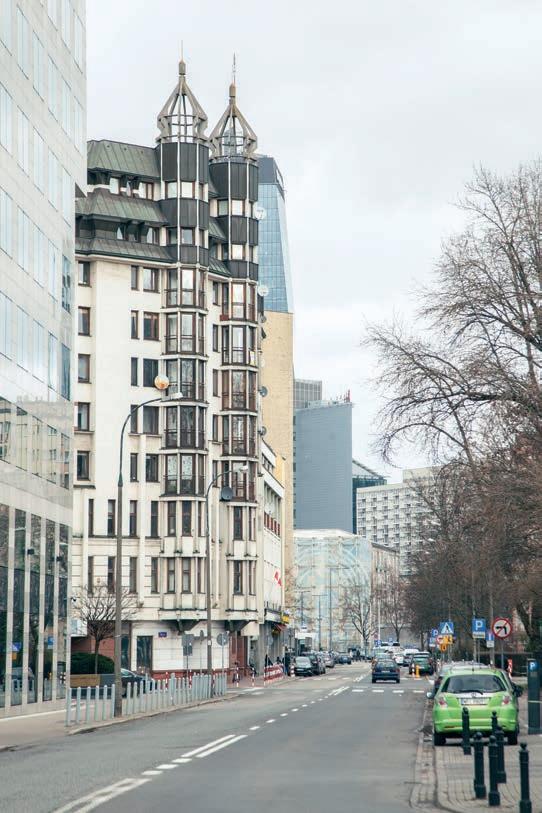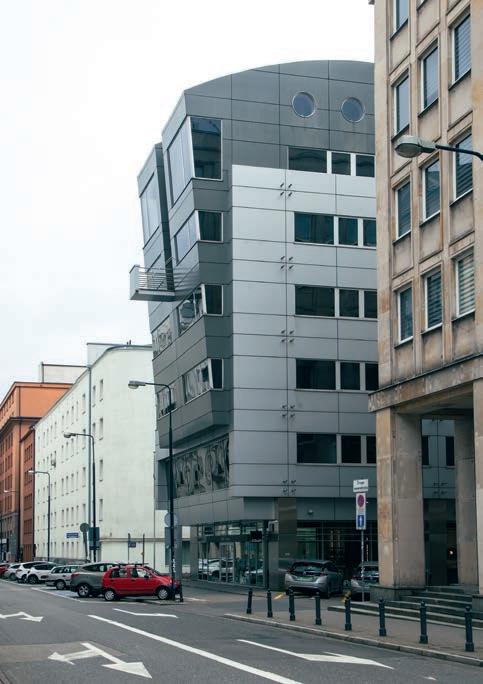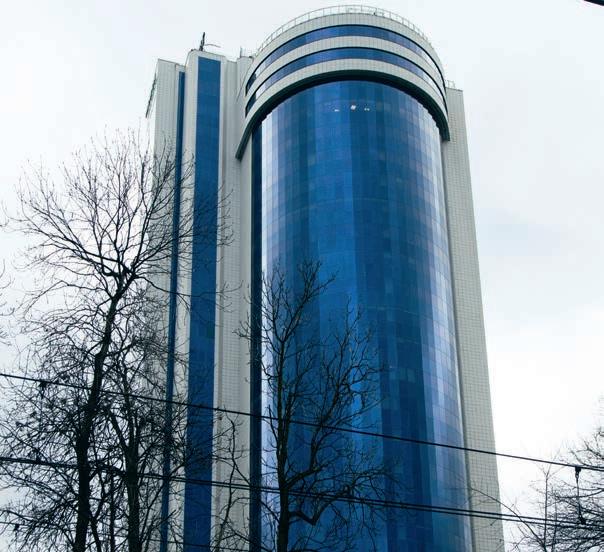
7 minute read
Back To The 90s!
After decades spent living in a controlled environment, the new freedoms offered by the 90s saw a temporary but collective loss of sanity in Poland – plunged headfirst into a bewildering capitalist world, Warsaw became a tapestry of color, chaos and contrasts. Physically manifesting itself by way of the city’s architecture, the years that have followed have seen many of these buildings negatively judged – much like someone looking back at the crappy suit they bought with their first pay cheque, for many the 90s style has come to be viewed as an awkward embarrassment: a reminder of a time when good taste was suspended in the rush to embrace perceived western ways of thinking.
As a result, the last few years have seen many of these buildings condemned – sometimes quite literally. Despite this, many critics are now appreciating these architectural styles for what they represent: a wild and unique time that will never be repeated. Moreover, as clunky and clumsy as many of these buildings may first seem, they have become iconic in their own right, and a vital part of the fabric that makes the patchwork of Warsaw so visually engaging.
For years subject to a backlash, the architecture of the 90s is undergoing an overdue reassessment…
Color Me Mad
Warsaw’s relationship with the rainbow has been complex at best – definitely though, the Rainbow Center (Jagiellońska 15) has fared far better than the rainbow installation that once stood spanning Zbawiciela (arson attacks: seven!). Taking its current form in 1997, it was actually first built in the 50s to serve as the PDT department store. Built as the commercial nucleus of Praga, in 1968 it was visited by over 3.5 million people. Come the political transformation, its popularity nosedived and in the mid-90s Pedet – as it was commonly called – was closed for good. Revived as an office block, it was clad in rainbow colored panels in a bid to breathe fresh life into what had become a decaying hulk.
Intensely jarring but also strangely stimulating, it remains a powerful beacon of 90s excess – but things aren’t always what they seem. As jolly as it might look, within its walls lurk the district’s taxmen.
Residential Rebirth
For decades, Warsaw’s residential sector had barely deviated in style or form – if the immediate post-war years were defined by Socialist Realist edifices, the 60s saw occasionally exotic bursts of modernism – a style that gradually lost out in favor of the vast panel blocks of the 70s and 80s.
Then along came the 90s… Often blockish in appearance, but decorated with curvy elements and colorful metal balconies, the new look apartments that rose were revolutionary at the time. Its unlikely though that anywhere will stop you in your tracks quite like Twarda 44. Notable for its pair of tall, Cathedral-like spires that soar into the air, this staggering work reached the final shortlist in a contest to find Warsaw’s best building from 1989-1995.
Masterpieces
Not every architect went nuts in the 90s. A graduate of Warsaw’s University of Technology, Stefan Kuryłowicz – who died in a plane crash in 2011 – demonstrated that aesthetics and creative expression were not mutually exclusive. Often credited with transforming the city’s architectural landscape, perhaps his finest work is the easiest to miss.
Slotted effortlessly between an anonymous, soul-grinding Socialist Realist ministry, and a teetering Art Nouveau tenement, Nautilus on Nowogrodzka 9 leans subtly outwards, its silvery skin blending seamlessly with the city’s grey skies. Featuring a bendy roof, circular portholes, and a balcony-like service point jutting over the street, it is a building that captivates all those who pass.
Now housing, among others, the Australian Embassy, it is a must on any architectural safari. “It was created on the wave of changes that took place after 1989,” explains his widow, Ewa Kuryłowicz. “It was a building that wanted to talk about its time and the opportunities it brought. And it brought freedom and everything that came with it.”
These sentiments could just as easily be applied to the university library or, to give it its local name, BUW (Dobra 56/66). Blessed by Pope John Paul II just before it was officially opened on December 15th, 1999, it was designed by Marek Budzyński and Zbigniew Badowski, and even by the haphazard standards of the 90s broke all known conventions.
Touting two distinct segments connected by a transparent overhead roof, it embraced nature way before such statements were on-trend. Fitted out with trellises, it was on these that a galaxy of plants were placed. No less impressive from the outside, the exterior, meanwhile, saw the addition of eight mint green panels inscribed with quotes in eight languages such as Hebrew, Sanskrit and Arabic.
Featuring also a garish indigo colored frame, the building rewards deeper exploration – a trip to its side, for instance, takes visitor on a trail that leads to what’s been hailed as “one of the largest and most beautiful rooftop gardens in Europe”. Every bit as space age as the building down below, wander sloping metal walkways and leafy alcoves whilst brushing past miniature apple trees and vine encrusted pergolas.

Nautilus on Nowogrodzka 9
Revamped & Reinvented
Long before Wola become the CBD it is today, office life was already flourishing. The 90s saw to that, with structures such as the Ilmet and Atrium helping transform Wola’s eastern border into a corporate wall of steel and glass. Beyond that, the long-demolished Mennica building offered up a formidable diamond black façade that had a mystery and menace that was repeated by the cluster of offices around Towarowa and Kasprzaka. Some we have lost already, others are slated for future destruction. A couple, though, have successfully resisted such drastic changes by adapting to the times.
Found close to the Warta Tower – a surviving example of sexy but intimidating glass architecture – the Hop (Chmielna 132/134) is a case in point. Looking increasingly ponderous amid the lithe skyscrapers on the horizon, it underwent a bold metamorphosis in 2021 that saw it repainted with smart, salmon-colored geometric elements. Friendly on the eye, it’s been praised as an example of intelligent redesign.
The Cause Célèbre
A unique product of its time, one of Warsaw’s best surviving examples of 1990s architecture stands to lose it extraordinary color after plans were leaked suggesting that its exterior would be repainted. Opened in 1992, and authored by architects Wolfgang Triessing and Maciej Nowicki, the Sobieski Hotel has often enjoyed a love-hate relationship with the Warsaw public.
Looming over Plac Zawiszy in a riot of color, the building’s façade was devised and painted by Hans Piccottini, an Austrian artist that sought to evoke the spirit of Warsaw’s Old Town through his use of bold, striking shades. Immediately, it divided Varsovians. Unleashing a wave of hate, the Sobieski was even named the worst building to be built between 1989 and 1995 in a joint poll conducted by Architektura-murator and Życie Warszawy.
Yet whilst its color schemes still have the ability to induce a brain hemorrhage, the building has undergone a rehabilitation of sorts – in 2020, it found itself included in the city conservator’s list of contemporary cultural assets. Although unwaveringly kitsch, several have praised the building for casting cheer on an otherwise glum chunk of Warsaw; yet others have lauded its ability to evoke childlike smiles through its high-impact colors. And in this increasingly sanitized city, many have pointed out how the Sobieski has become an almost historical testament to the most bizarre and energetic period of Warsaw’s recent history.
It is these very colors, though, that are now under threat after it was revealed in February that the building’s owners were seeking to repaint it using a more subtle palette. With many of the city’s prime examples of 90s architecture already dismantled or otherwise transformed beyond recognition, the news has sparked fierce debate among residents with nostalgists fearing that soon all traces of this vibrant, thrilling period will be lost forever.
Growing Up
The decade saw the skyline change irrevocably with new skyscrapers capturing the capital’s Dynasty-style aspirations. These included the 27-storey Central Tower which, on account of its then peach and blue colored panels, quickly became established as one of Warsaw’s ugliest buildings, a title it held with pride till opting for a tasteful recent facelift; there was Ilmet, with its clunky styling and revolving rooftop Mercedes badge; and Wola’s original skyscraper, the 208-meter Warsaw Trade Tower which was built on the orders of Daewoo before their spectacular collapse.
But most notorious of all, there’s what’s now known as the Atlas Tower. Often likened to a portable toilet, a shower tub or, even, a Red Bull can in the grip of a vice, it was the brainchild of Vahap Toy, a controversial businessman whose plans for Poland included transforming the backwater town of Biała Podlaska into a Vegas-inspired resort complete with an F1 track, replicas of the Seven Wonders of the World and an Olympic stadium. Looking top heavy and contextually out-ofplace, no other tower compares when thinking of the 90s.


Hotel Highs
Surprisingly subtle given much of the vulgarity of the era, the Sheraton (B. Prusa 2) was completed in 1996 and won instant critical praise for the way it integrated into its surrounds – apart from, that is, those who lived directly opposite. In a city still unfamiliar with the concept of reflective glass, local residents initially complained that they could see what their next door neighbors were doing. Replacing a grove of trees that had grown here ever since the Nazis had burned down the Napoleon Cinema, the Sheraton’s launch was greeted enthusiastically by the press. Gazeta Wyborcza, for instance, gushed about the 24hr fax facilities and the eyewatering USD 350 rooms.


Constructed with a large bay window as its principal visual anchor, the building was topped with a circular, wraparound crown. Like the Marriott – which had opened seven-years previously – it became an island of largesse and prosperity, and few veteran expats will ever forget the long nights of carousing in the Someplace Else bar whilst simultaneously beating away the unsolicited advances of foreign financial advisors. Since hosting the likes of Al Gore, Tony Blair, the Dalai Lama and Pamela Anderson, the hotel traded its original interiors in 2019 for something more contemporary and restrained. From the outside though, it still carries an unmistakably 90s optimistic swagger.
Historical Rewrites
Fusing the historical with the contemporary, the 90s saw a fleet of architects challenging tradition in a way that had rarely been seen before. Rebuilt from scratch, the Jabłonowski Palace overlooking Pl. Teatralny saw a façade erected following the pre-war plan. Spectacularly convincing, only a deeper look behind and to the sides of the building reveals as a new build. Then, how about Powiśle’s Grey Villa (Wybrzeże Kościuszkowskie 47). Built in 1905, but ravaged during the war, its 90s modernization saw the addition of a glass ceiling and transparent tower. Executed with skill, the merger between new and old impresses as much now as it did back then.








